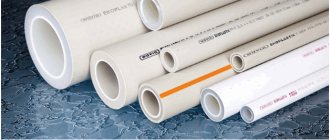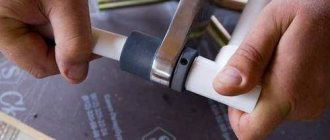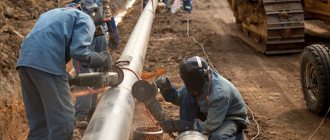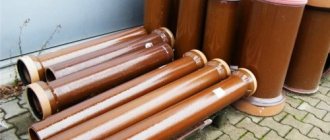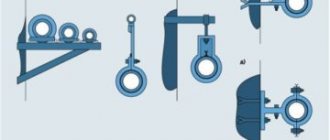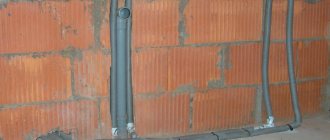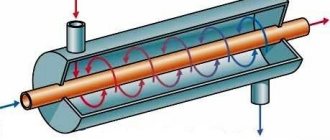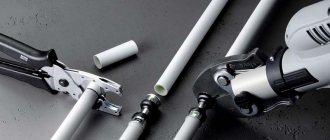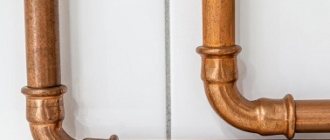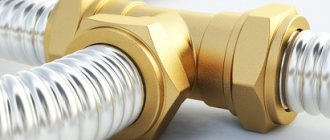Since ancient times, pipes made of various metals - cast iron, steel, copper - have been used for water heating systems. The price of metals is constantly growing, which means that the price of pipes made from them is also increasing. Installation of heating systems made of metal pipes is impossible without the use of electric welding, which increases the cost of installation work. Sometimes it is impossible to do without the use of metal pipes, but in all other cases, modern polypropylene pipes make it possible to easily create a circuit at lower financial costs. It is important that the real cost of a polypropylene heating pipe, and therefore the entire circuit, is lower than the price of a heating system made of metal pipes.
Is it possible to use plastic pipes for heating?
Plastic quickly loses technical characteristics when exposed to high temperatures. Therefore, when choosing plastic pipes for heating, you need to select products that meet a number of requirements:
- The plastic must be able to withstand the temperature of the coolant. The maximum temperature is 95 degrees. At this temperature, the pipes should not be deformed.
- The pipes must withstand high pressure so that water hammer occurring in the system cannot destroy the pipeline.
- Minimum coefficient of thermal expansion. Otherwise, individual elements of the pipeline will sag when heated. When temperatures drop, internal stresses may occur, which negatively affect the strength of the tubes.
- The pipes must be straight from the inside. If this requirement is not taken into account, plaque will accumulate on the inner walls, which will lead to blockages.
- Pipeline elements should not be destroyed when exposed to various chemicals that may be contained in tap water.
- The individual elements from which the heating circuit is assembled must be durable in order to function for a long time without breakdowns.
- The pipes must have a high level of sound insulation so that the flow of water cannot be heard in the rooms.
Plastic pipes meet all the necessary requirements, but they have one serious drawback - a high coefficient of thermal expansion. Because of this, long tubes can sag when heated. To prevent this, you need to install special compensators. They minimize the risk of tube deformation during thermal expansion and increase the strength of pipeline joints.
Why polymer and not metal?
- Until recently, heating circuits were constructed exclusively from metal ducts. Modern polymer channels can withstand temperatures up to ninety-five degrees. At the same time, they can withstand high pressure levels. Therefore, they are not inferior to their metal counterparts.
- Polymer products are resistant to corrosion processes. They are chemically inert and do not react to acids, alkalis and other aggressive environments.
- The inner surface of the polymer structure is very smooth. It is characterized by an extremely low roughness index. Therefore, plaque does not form inside the channels and the passage does not become overgrown.
- In terms of installation, polymer pipes are more convenient than metal ones. They are characterized by low weight and are easy to install without the use of complex and expensive equipment. In most cases, even a non-professional can install a circuit made of polymer products.
Characteristics
Technical characteristics determine the scope of application of the products. The manufacturer indicates them on the packaging of the pipes or on the plastic surfaces themselves. Options:
- the material from which the parts are made;
- diameter of plastic pipes;
- maximum coolant temperature;
- the maximum pressure that the pipe can withstand;
- sizes of plastic pipes for heating.
To indicate characteristics, a labeling system for products made from different types of plastic was developed.
Pipes for hot coolant
Marking
There are several types of plastic used to make pipelines:
- PVC pipes;
- polypropylene products;
- polyethylene parts.
A separate group includes tubes, during the manufacture of which a reinforcing layer of aluminum foil or fiberglass is placed between layers of plastic.
The marking varies depending on the type of polymer. There is no point in describing the designations on PVC, since this material is not used for the manufacture of water supply and heating pipelines. This type of polymer releases harmful substances when heated and has low performance characteristics.
Polyethylene marking:
- PE 32 is a type of polyethylene with the lowest density. It is rarely used for making pipes.
- PE 63 - used for assembling non-pressure systems. This could be sewer drains, an outdoor shower. This type of polyethylene cannot withstand high pressure and is destroyed by water hammer.
- PE 80 is a type of polyethylene with a high strength index. Used for assembling cold water supply systems. If the pipeline is laid outside buildings, additional insulation must be used.
- PE 100 - pipes made from this type of polyethylene have the highest strength index. They are used for the manufacture of industrial pipelines, hot and cold water supply systems, heating circuits.
The marking of polyethylene tubes contains the abbreviation SDR, followed by numbers. The lower this indicator, the stronger the product.
Marking of polypropylene tubes:
- PN10. Products with this designation can withstand pressure up to 1 MPa. The permissible liquid temperature is 45 degrees Celsius. Due to their low strength and heat resistance, such tubes are used for assembling sewage drains and cold water supply pipelines.
- PN16. The maximum permissible pressure level is 1.5 MPa. The coolant temperature should not exceed 60 degrees. Popular for the manufacture of cold water supply systems. Rarely used for assembling hot water circuits.
- PN20. Tubes made of this type of polypropylene can withstand pressure up to 2 MPa. The maximum permissible coolant temperature is 80 degrees. Used for assembling hot and cold water supply systems, heating circuits.
- PN25 is the most durable type of polypropylene. This material can withstand pressure up to 2.5 MPa. The coolant temperature can rise to 95 degrees. Withstands temperature surges - up to 110 degrees.
Marking of multilayer products:
- PPR - the outer layer of the tubes is covered with polypropylene;
- AL - has a reinforcing layer of aluminum foil;
- PP-RCT is a designation for modified polypropylene, which has increased thermostatic properties.
If there is a layer of fiberglass inside the pipe, the marking will contain the letters FG, FR.
Heating pipes made of polypropylene
Diameter
Depending on the characteristics of the water supply system, both metal and polymer products are selected. The size of their internal diameter can vary from 10 to 1200 mm, and production is standardized.
According to this parameter, products are divided into three types:
- 20, 25, and 32 mm are the most popular parameters for domestic water supply and heating lines;
- 40, 50, 63, 75, and 90 mm - suitable for centralized supply of heating and water supply systems in multi-storey buildings;
- 110, 125, 160, 200 and higher are used in low pressure pipelines or for organizing sewage drains.
Products with a diameter of up to 16 mm are practically not used in water and heat supply systems.
Varieties
You can find different types of plastic pipes that are used to make pipelines. Types of pipes used for assembling heating circuits:
- Polypropylene. A material that is most often used in the manufacture of pipelines for heating, cold and hot water supply. This is due to the many advantages of this material and low price.
- Cross-linked polyethylene. Tubes made of this material are more expensive than polypropylene. Suitable for installation indoors and outdoors. Withstands temperatures from -50 to 100 degrees. Destroyed by prolonged exposure to ultraviolet rays. Because of this, they need to be mounted in protective housings.
- Metal-plastic products. Such tubes are often used in the manufacture of pipelines. The parts consist of several layers - an outer and an inner layer of polyethylene. Between them there is aluminum foil.
The choice of material depends on the operating conditions and required technical characteristics.
Advantages and disadvantages
Advantages:
- Plastic pipes do not collapse when exposed to moisture for a long time.
- The material is environmentally friendly. It does not emit harmful substances when heated.
- Due to low thermal conductivity, water reaches the heat exchangers without cooling.
- The average service life under normal operating conditions without overload is 50 years.
- Thanks to the high sound insulation of the material, the sound of water flowing through the pipes is not heard in the rooms.
- Plastic parts are easy to transport and assemble together without the help of others.
- Plastic does not deform when exposed to chemicals that may be contained in pipeline water.
- Plastic tubes have smooth inner walls. Thanks to this, plaque does not accumulate on them.
Flaws:
- High coefficient of linear expansion. It must be taken into account when connecting individual pipeline elements.
- Low heat resistance. Therefore, when installing a pipeline outdoors, you need to use additional insulation.
- The material ages faster when exposed to ultraviolet rays.
If pipes are mounted on vertical surfaces, more fasteners must be used to prevent individual pipeline elements from sagging.
Easy pipe installation
Features of production technology
From a technological point of view, the production of polymer pipe products is considered simple. To launch a production line for the production of these pipes, it is necessary to prepare a room with an area of approximately 100 square meters. The manufacturing process of products does not require much electricity consumption.
Installation of just one line can ensure continuous maintenance of all technological processes. The production of polymer pipes is environmentally friendly.
Production of products occurs as follows:
- Granulated polymer is supplied into the working chamber using compressed air, where it is heated. The starting material then becomes molten plastic.
- Then it is squeezed into the forming head using a special device - a screw hydraulic or pneumatic press. The length of the screw of this device is about 30 diameters of the ejected products. Thanks to this design, it is possible to reduce the tremors of the melt, as a result of which the quality of the manufactured products increases. If a pipe with thin walls is being produced, a press with screws moving in the axial plane is used, which makes it possible to adjust the size of the gap between the mandrel head and the end of the screw.
- The formed product enters the calibrator for cutting and turning in accordance with the standards.
- After this, the products are immersed in a special bath for cooling.
- At the next stage, the corresponding marks are applied using a dot matrix printer.
- The products are checked again using optical element equipment and calibrated again.
- If the pipe diameter is more than 50 millimeters, it is cut in a circle with a guillotine or circular saw. Finished products are stacked. With a diameter of less than 50 millimeters, a special device is used to place the product in a coil. The pipes are pulled out of the furnace using the same winding equipment.
Spiral pipe products are produced using a special technology. When the polymer tape is extruded, it is wound onto round reinforcement and then the places where the turns touch are soldered. After winding is completed, the pipes are cut and removed from the fittings. Such products are characterized by high strength and do not transfer heat to the surface.
Installation
To make a heating system from plastic pipes, you do not need to hire builders. To do this, you need to prepare tools, materials and do the work yourself. Stages of work:
- Prepare heating pipes in a private house or apartment. They are cut to the required sizes using special scissors. The edges are cleaned of dirt, dust, and degreased.
- Connections of individual elements can be made using couplings or butt joints. To do this you need to use a special soldering machine.
- After heating the individual parts on a heated soldering iron, they are connected to each other.
All that remains is to wait for the plastic to cool and perform a test run of the pipeline.
Plastic pipes are becoming more popular every year. This is due to the technical characteristics of the material and low price. To assemble heating systems, you can use different types of polymers. When choosing a material, you need to take into account a number of requirements and features. After purchasing individual pipeline elements, you can assemble it yourself. To do this, you need to study the technology and carry out installation work.
Welding of polymer pipelines
The process of welding heating pipes made of polymers has a number of features. A special soldering iron is used to connect polypropylene products. Modern welding machines allow you to do the work yourself, even without the appropriate skills.
PVC pipes are welded in the same way. For these products, using a soldering iron allows you to create the most durable and economical connection option in the shortest possible time.
Metal-plastic pipe products are installed using special parts - fittings. In some cases, when joining products with a diameter of no more than 40 millimeters, the use of the cold welding method is allowed. For pipes with large diameters, installation devices must be used.
As a result of welding polymer pipes, high-quality connections are obtained, and this despite the fact that the simplest and most inexpensive equipment is used for this. This circumstance is an undeniable advantage of polymer products compared to metal products.
